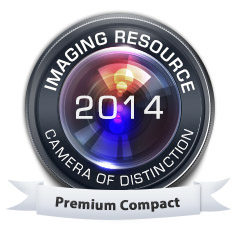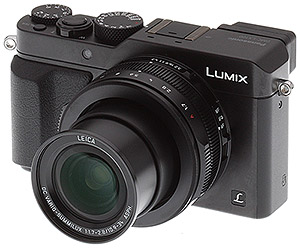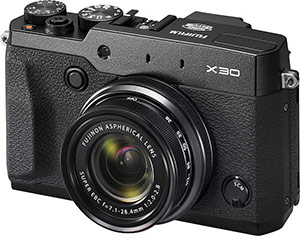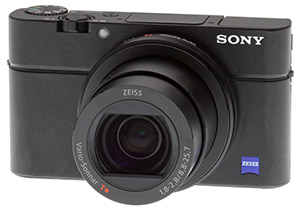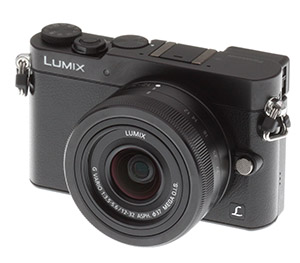Cameras of the Year: Best Compact Cameras of 2014
posted Friday, December 26, 2014 at 2:30 PM EDT
The Imaging Resource Camera of the Year Awards

Best Compact Cameras of 2014
In Parts I and II of our Cameras and Lenses of the Year series, we were wowed by the quality of the entry-level cameras and the best lenses of 2014. Fortunately, the new compact cameras of 2014 were no less impressive. Despite (or perhaps because of) competition from cellphones, the premium end of the compact camera space is seeing some of the most interesting releases in years. While Sony's venerable RX100 series (Battle of the RX100s) now has a lot of company in the high-end pocket camera market, the RX100 III still took top prize for our Pocket Camera of the Year this year. That makes it the third year that the RX100 series has enjoyed a Camera of the Year award (2012, 2013)! But there are now some really interesting options if you relax your pocketability requirement a bit. Read on to find out more about four compact cameras that all of us at IR would love to own...
Camera of the Year, Best Premium Compact Camera: Panasonic LX100
If pocketability isn't an overriding concern, the Panasonic LX100 is a very strong choice for a compact camera. How strong? Not only is it the best Premium Compact camera of 2014, it's probably the best premium compact camera ever. Let's review why we love this thing so much.
First of all: Panasonic's LX100 features a comparatively massive Micro Four Thirds sensor. That gives you almost twice the sensor area as otherwise similar compact cameras like the Sony RX100 III (our Camera of the Year in the Best Pocket Camera category, see below, or RX100 III vs LX100) and the Canon G7X (G7X vs LX100). And the large sensor and modest pixel count gives you larger pixels than just about any other compact camera on the market -- even approaching (APS-C) DSLR territory! The D7100 (D7100 vs LX100), for instance, has an approximate pixel pitch of 3.92 microns, vs the LX100 at 3.86. Those large pixels make for great sensitivity and awesome low light performance. Another cool feature: Panasonic included a multiple aspect-ratio sensor that allows more horizontal and vertical resolution for wider and taller aspect ratios, respectively. Other manufacturers just lop off pixels to give you alternate aspect ratios. (Note that the nature of Panasonic's sensor means our pixel pitch measures are just approximations.)
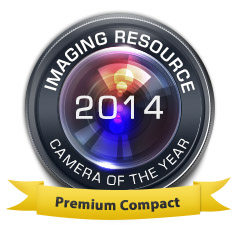
And it's not just about the sensor, but everything else that Panasonic crammed into this pint-sized wonder as well. The LX100 has the largest sensor ever seen in a compact camera with an f/1.7 zoom lens and the largest sensor ever seen in a compact camera with an EVF. Canon's G1 X (G1 X vs LX100) has a slightly larger sensor, but only has a tunnel viewfinder, its lens is limited to f/2.8 and it's a much larger camera, and while the G1 X Mark II (G1 X Mark II vs LX100) has a similarly-sized sensor and an f/2.0 lens, it's still a larger camera and has no viewfinder. And that's pretty much it for large sensor zoom compacts. The LX100 really stands alone in its combination of lens, sensor and viewfinder.
Oh, and this little thing SHOOTS 4K VIDEO. That makes the LX100 the first compact camera to shoot 4K video. How's that for a victory lap? We'll admit that 4K is a pain to edit and limited in current utility, but it does give you a couple exciting possibilities for your post-production workflow: You can downsample the 4K output to 1080p in post to get absolutely stellar video quality, or crop in and apply serious image stabilization, yet still end up with full 1080p output.
Buy from Adorama | Buy from Amazon | Buy from B&H Photo
Camera of Distinction, Premium Compact Camera: Fujifilm X30
The Fujifilm X30 is the third revision of Fuji's unique X-series premium compact cameras. It maintains the same imaging pipeline as the previous X20 model (X20 vs X30): a 12-megapixel 2/3-inch X-Trans II CMOS sensor, EXR Processor II chip, and a 4x optical zoom lens (28-112mm equivalents) with a nice and bright f/2-2.8 aperture range.
With the X30, the distinctive retro-inspired exterior gets a bit more modernized with a sharper, chiseled shape and an improved rubberized, grippy surface. Fuji improved usability with more manual controls, a tilting 3-inch LCD, and a bright OLED electronic viewfinder to replace the parallax-plagued optical one from the X20. Battery life also gets a boost and the addition of built-in Wi-Fi adds easy, robust remote control and photo-sharing capabilities.
Performance-wise, the X30's image quality is impressive with lush colors, nice sharpness and smooth tones. High ISO performance is equally impressive for a camera in this class, and the hybrid contrast-detect and phase-detect AF system is quick and accurate for most things, save for very fast-moving or very low-contrast subjects. The X30 is also filled with tons of image customization, including Fuji's trademark film simulation presets as well as a host of digital effects (Fujifilm is probably the only company from whom we're actually delighted to try out the effects modes). The Fujifilm X30 is the camera to choose if you want a top-quality premium compact camera with great performance and a stylish design that sets it apart from the crowd.
Buy from Adorama | Buy from Amazon | Buy from B&H Photo
Camera of the Year, Best Pocket Camera: Sony RX100 III
It's no secret that we've been in love with Sony's RX100-series enthusiast pocket cameras ever since the line's debut back in 2012. Now in its third iteration, the Sony RX100 III finally faces a formidable opponent in the Canon G7X (G7X vs RX100 III), but it's still the Sony that we're most likely to reach for when we're traveling light.
While it might not have quite the same zoom range as that of the G7X, the Sony RX100 III bests its new rival in several important ways. For one thing, it sports a clever popup electronic viewfinder, there when you need it most, but hidden and protected inside the camera body the rest of the time. Sony's more sophisticated tilting LCD monitor also strikes us as a very worthwhile feature, and the RX100 III's image quality -- especially in the corners at wide angle -- is noticeably better. And raw shooters like ourselves will also prefer the RX100 III for its much better burst performance.
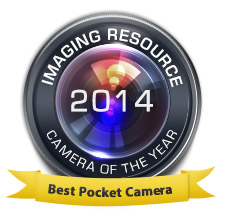
While the RX100 III isn't quite as compact as its predecessors, and lacks the flash hot shoe of the RX100 II (RX100 II vs RX100 III), overall we found it to be the most mature and well-considered entry in the RX100-series lineup to date. It still fits comfortably in a pants pocket or small purse, and thanks to a larger image sensor than any other pocket camera save for its siblings and the G7X, it represents the state of the art in enthusiast compact image quality.
Whether you're looking for a second, smaller camera to accompany your DSLR or mirrorless camera kit, or you're looking to step up from the limited image quality of a smartphone or smaller-sensored camera, you really can't go wrong with the Sony RX100 III. It's fun to shoot with, makes it easy to get your artworks online through your smartphone, and best of all, you can almost forget you're carrying it -- until the moment you need it most.
Buy from Adorama | Buy from Amazon | Buy from B&H Photo
Camera of the Year, Best Pocket ILC: Panasonic GM5
There was -- and still is -- a lot to love about the Panasonic GM1 (GM1 vs GM5), the micro Micro Four Thirds camera released last year: very fast autofocus, excellent image quality, compatibility with the full Micro Four Thirds stable of lenses, and, of course, an extremely compact and lightweight design. In fact, the GM1 spawned the creation of the "Pocket ILC" category in last year's Camera of the Year awards, and obviously took that award. This year, it seems the follow-up model, the Panasonic GM5, once again stands alone in this category and takes the crown as Best Pocket ILC once more.
The Panasonic GM5 takes the best of the GM1 and fine-tunes it to address most of the shortcomings of the original model, adding an EVF, 1080/60p video, and a special T-mode, which is similar to Bulb exposure mode. The GM5, nevertheless, keeps the same 16MP Live MOS sensor and Venus Engine for excellent image quality and great high ISO performance for a Micro Four Thirds camera. Autofocus performance remains very quick, and continuous burst shooting with full-time AF is slightly faster.
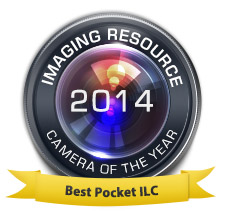
The physical changes are the most noticeable, with the built-in EVF being the big highlight feature. While it's rather small, it does its job well and makes shooting in sunny or glare-filled situations much easier. The ergonomics have also been improved, with a larger, raised thumb rest, two customizable physical function buttons, and a true clickable, scrollable sub-control dial.
All in all, the Panasonic GM5 is a fantastic camera -- a solid improvement over an already-great pocketable fixed-lens compact camera; the ideal travel camera with the creative flexibility of interchangeable lenses, or the perfect secondary camera for any Micro Four Thirds photographer. If you want to step into the world of interchangeable lenses, but still want a very small, lightweight camera with great image quality and performance, it makes a lot of sense to pick the Panasonic GM5.
Buy from Adorama | Buy from Amazon | Buy from B&H Photo
Imaging Resource Cameras and Lenses of the Year Awards
This is Part III in our multi-part Cameras and Lenses of the Year Awards for 2014. We previously announced our picks for the Best Entry-Level Cameras of 2014 and the Best Lenses of 2014. Look for our awards for best Professional and Enthusiast cameras of 2014 and our overall choice for the Camera of the Year next week.
Best Entry-Level Cameras of 2014
Best Compact Cameras of 2014 (this page)
Best Professional & Enthusiast Cameras of 2014
Camera of the Year, 2014 (and Special Awards) coming soon
